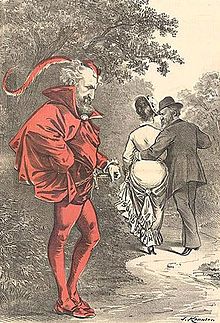This is an old revision of this page, as edited by Jmabel (talk | contribs) at 18:21, 20 January 2007 (Replace link to image with image itself). The present address (URL) is a permanent link to this revision, which may differ significantly from the current revision.
Revision as of 18:21, 20 January 2007 by Jmabel (talk | contribs) (Replace link to image with image itself)(diff) ← Previous revision | Latest revision (diff) | Newer revision → (diff)
The Compromise of 1877 was an informal, unwritten deal that settled the disputed 1876 U.S. Presidential election. Through it, the Republican Rutherford Hayes was awarded the White House on the understanding he would remove the federal troops that were propping up Republican state governments in South Carolina, Florida and Louisiana. Consequently, the incumbent President, Republican Ulysses Grant, removed the soldiers from Florida, before Hayes as his successor removed the remaining troops in South Carolina and Louisiana. As soon as the troops left, many Republicans also left (or became Democrats) and the "Redeemer" Democrats took control.
The 1876 election showed a one-vote electoral college majority for the Republicans, but the Democrats protested and two sets of official results were sent to Congress by South Carolina, Florida and Louisiana. An official Electoral Commission selected by Congress awarded the election to Hayes. Southern Democrats planned to block the Commission's report via filibuster. The Southerners had a weak hand, and the Republicans made promises that kept them quiet. The compromise resolved the crisis through a series of secret negotiations involving Republican and Democratic politicians, various interest groups and influential individuals, most notably the Texas and Pacific Railway company and its president, Tom Scott of the Pennsylvania Railroad, who had also served as Assistant Secretary of War during the Civil War.
The compromise essentially consisted in that Southern Democrats would acknowledge Hayes as President, but only if the Republicans acceded to various demands, specifically the first:
- The removal of all Federal troops from the former Confederate states. (Troops only remained in Louisiana, South Carolina, and Florida, but the Compromise finalized the process.) Hayes had already promised to do this.
- The appointment of at least one Southern Democrat to Hayes' cabinet (David M. Key of Tennessee was appointed Postmaster General.) Hayes had already promised this;
- The construction of another transcontinental railroad using the Texas and Pacific in the South (this had been part of the "Scott Plan" which initiated the process which led to the final compromise);
- Legislation to help industrialize the South.
Points 1 and 2 took effect; 3 and 4 never happened.
The informal agreement satisfied southern Democrats and there was no filibuster. Hayes was inaugurated on schedule and removed the troops (Grant had already removed some). There was no serious effort made to fund a railroad or provide other federal aid. An opposing interest group representing the Southern Pacific successfully thwarted Scott's Texas and Pacific scheme and ultimately ran its line all the way to New Orleans. Some historians argue that the agreement should not be called a compromise (Peskin 1973). Others emphasize that the Republican party abandoned the Southern Blacks (DeSantis, 1982). In any case, Reconstruction ended and the supremacy of the Democratic party – and white supremacy – in the South was cemented with the ascent of the "Redeemer" governments that displaced the Republican governments. After the Compromise of 1877, white supremacy generally caused the South to vote solidly Democratic (the "Solid South") until 1964.
References
- Benedict, Michael L. "Southern Democrats in the Crisis of 1876-1877: A Reconsideration of Reunion and Reaction". Journal of Southern History 46 (November 1980): 489-524; Says the Compromise was reached before the Wormley hotel meetings discussed by Woodward (1951)
- DeSantis, Vincent P. "Rutherford B. Hayes and the Removal of the Troops and the End of Reconstruction". In Region, Race and Reconstruction Ed. by Morgan Kousser and James McPherson. New York: Oxford University Press, 1982. 417-50. Provides a more complex account of Hayes's decision.
- Allan Peskin, "Was There a Compromise of 1877?" Journal of American History (1973) v 60#1, pp 63-75 (Admits that Woodward's interpretation is almost universally accepted but since not all terms were met it should not be called a compromise.)
- Polakoff, Keith Ian. The Politics of Inertia: The Election of 1876 and the End of Reconstruction. Louisiana State University Press, 1973. Argues the Compromise reflected decentralized parties and weak national leaders
- C. Vann Woodward. Reunion and Reaction: The Compromise of 1877 and the End of Reconstruction (1951), emphasizes the role of railroads.
- C. Vann Woodward. "Yes, There Was a Compromise of 1877" Journal of American History (1973) v 60#2, pp 215-23. (Rebuts Peskin; the main terms were indeed met.)
- Hayes Presidential Library